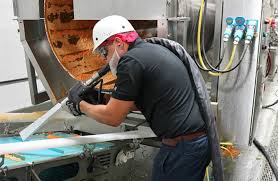Flooded deep-cycle batteries are vital in renewable energy storage and backup power systems. Renowned for their cost-effectiveness and dependability, these batteries have been integral to numerous applications, including golf carts, marine vessels, and solar energy storage. Despite their widespread use, several myths and misunderstandings surround their performance, lifespan, and maintenance needs. The intricate construction of these batteries involves a liquid electrolyte that requires periodic maintenance, distinguishing them from sealed or maintenance-free alternatives. Their design allows for high capacity and robust cycling abilities, which are particularly suited for applications involving frequent discharge and recharge cycles. This blog seeks to clarify the practical aspects and dispel common misconceptions about flooded deep cycle battery, offering a comprehensive understanding of their functionality and advantages.
Performance Testing For Flooded Lead Acid Deep-Cycle Batteries
Performance testing for flooded lead acid deep-cycle batteries involves a series of evaluations to gauge their overall health and effectiveness. Key parameters assessed during testing include capacity, efficiency, and discharge rates under various conditions. These tests help determine how well a battery performs in real-world scenarios, revealing crucial insights into its ability to hold and deliver charge. Evaluating these metrics is essential for identifying potential issues early, allowing for timely corrective measures.
Additionally, performance testing aids in optimising charging protocols and load management strategies, ensuring the battery operates at peak efficiency. This information is invaluable for extending the battery’s operational life and enhancing the reliability of the systems it supports.
Lifespan of Flooded Lead Acid Deep Cycle Batteries
Several key factors significantly influence the lifespan of flooded lead-acid deep-cycle batteries. Proper temperature management plays a critical role, as high temperatures can expedite the deterioration of battery components. Usage patterns, particularly the depth and frequency of discharges, also have a substantial impact on longevity. Batteries that undergo regular deep discharges tend to have a shorter lifespan.
Maintenance practices, including periodic equalisation charging and timely electrolyte top-ups, can markedly extend the battery’s service life. Additionally, ensuring that batteries are not left in a discharged state for prolonged periods helps prevent sulphation, a common cause of capacity loss. By understanding and addressing these influencing factors, the operational life of flooded lead acid deep cycle batteries can be maximised.
Characteristics of Flooded Lead Acid Deep Cycle Battery
Flooded lead acid deep-cycle batteries are known for their robust design and durability. Unlike their sealed counterparts, these batteries utilise a liquid electrolyte composed of sulphuric acid and water, which must be periodically topped up to maintain optimal performance. This liquid electrolyte facilitates efficient ion exchange, essential for the battery’s ability to endure frequent discharge and recharge cycles. The internal components, such as the lead plates, are specifically designed to handle deep discharges without significant degradation, a key feature for applications requiring sustained energy output.
The construction allows for efficient heat dissipation, reducing the risk of overheating during intensive use. Additionally, these batteries are equipped with removable caps that enable users to monitor and maintain electrolyte levels, a crucial aspect of their upkeep. The ability to perform equalisation charges, which involves overcharging the battery slightly to mix the electrolyte evenly, is another characteristic that helps prolong their operational life.
This process also prevents stratification, where the acid concentration varies within the cell, impairing performance. Overall, the specific construction and design elements of flooded lead acid deep cycle battery make them highly suitable for demanding energy storage applications.
Maintenance of Flooded Deep Cycle Batteries
Regular maintenance ensures flooded deep-cycle batteries’ optimal performance and longevity. Following a few key practices can prevent common issues such as sulfation, corrosion, and electrolyte loss. Below are five essential maintenance tasks to keep your batteries in top condition.
Monitor and Maintain Electrolyte Levels
Flooded deep-cycle batteries require regular checks of electrolyte levels to ensure the lead plates remain submerged. If levels drop, top up with distilled water—never tap water—to avoid mineral buildup. Low electrolyte levels can expose plates, leading to irreversible damage and reduced battery life.
Clean Battery Terminals Regularly
Corrosion on terminals can hinder electrical conductivity and reduce efficiency. Inspect terminals periodically and clean them using a mixture of baking soda and water. A wire brush can help remove stubborn corrosion, ensuring a strong connection and optimal performance.
Perform Equalisation Charging
Equalisation charging involves a controlled overcharge to mix the electrolyte and prevent stratification. This process helps balance cell voltages and removes sulphate buildup on plates, improving overall battery efficiency and lifespan.
Store Batteries Properly
Store batteries in a cool, dry place away from extreme temperatures when not in use. Avoid leaving them in a fully discharged state, which can lead to sulfation and permanent capacity loss.
Inspect for Physical Damage
Check the battery casing regularly for cracks, leaks, or bulging. Early detection of physical damage can prevent hazardous leaks and costly replacements. Address any issues immediately to maintain safety and functionality.
Operation of Flooded Cell Deep Cycle Battery
Flooded cell deep cycle batteries harness chemical reactions within their electrolyte to store and release energy. When charging, electrical energy converts the lead sulphate on the battery’s plates back into lead dioxide and lead while the electrolyte’s sulphuric acid concentration increases. The chemical process reverses during discharge, and energy is released to power various devices. The design of these batteries ensures they can sustain deep discharges, making them ideal for applications such as solar power systems and marine use.
Managing the charging cycle is crucial, as improper charging can lead to issues such as sulphation or excessive gassing. Automated chargers that adjust voltage and current can be beneficial in maintaining the battery’s health. The ability to perform equalisation charges helps maintain the electrolyte’s homogeneity, ensuring each cell operates efficiently.
The design also allows natural ventilation to release any hydrogen gas generated, preventing pressure build-up. Regularly monitoring and maintaining the electrolyte levels and connections are essential for optimal performance. Proper handling and storage further ensure the flooded cell deep cycle battery longevity and reliability in delivering consistent power across varied applications.
Safety Considerations for Flooded Cell Deep Cycle Batteries
Flooded cell deep cycle batteries require strict adherence to safety protocols due to the hazards associated with acid and hydrogen gas. Handling these batteries necessitates using protective gear, such as gloves and safety goggles, to avoid direct contact with the acid. Ensuring the storage area is well-ventilated is crucial to prevent the build-up of hydrogen gas, which can pose a significant explosion risk if not adequately managed. Routine inspections are vital to detect leaks, cracks, or corrosion that could lead to potential hazards.
When performing maintenance, it is essential to use non-conductive tools to prevent accidental short circuits. Proper signage and labelling in storage areas can help alert personnel to the presence of hazardous materials, thereby promoting a safer working environment. Additionally, it is advisable to have neutralising agents like baking soda on hand to address any acid spills quickly.
Environmental Impact of Flooded Deep Cycle Batteries
The environmental impact of flooded deep-cycle batteries primarily revolves around their production, usage, and disposal processes. The extraction and processing of raw materials such as lead and sulphuric acid during manufacturing can pose ecological concerns if not managed responsibly. The operational phase also has implications, particularly regarding energy consumption for charging and the potential release of hydrogen gas, which must be vented to avoid environmental hazards.
The disposal of these batteries presents significant environmental challenges. Improper disposal can result in the release of toxic substances, leading to soil and water contamination. However, recycling can mitigate these effects. Many components, including lead and plastic casings, are recyclable, reducing waste and conserving natural resources. Recycling programmes minimise ecological harm and recover valuable materials for reuse, supporting a circular economy.
Additionally, advancements in battery technology are helping to lessen the environmental footprint. Innovations to improve energy efficiency and extend battery lifespan contribute to reduced resource consumption and waste generation. These efforts align with broader ecological sustainability goals, highlighting the importance of responsible battery management practices throughout their lifecycle.
Technological Developments in Flooded Lead Acid Deep Cycle Batteries
Technological developments in flooded lead acid deep cycle batteries have significantly enhanced performance and durability. Recent innovations include advanced plate designs that increase surface area and improve energy efficiency. Improved separators, which prevent short circuits and minimise water loss, contribute to a more stable operation. Additionally, advancements in lead alloys have reduced corrosion rates, thereby extending the battery’s operational life.
Enhanced charging algorithms are another key development, allowing more precise control over the charging process. These algorithms optimise charge cycles to reduce the risk of overcharging and sulphation, thereby improving the overall efficiency and longevity of the batteries. Furthermore, the integration of intelligent monitoring systems enables real-time tracking of battery health, providing valuable data that can be used to address maintenance needs preemptively.
These technological strides bolster the performance of flooded lead-acid deep-cycle batteries and make them more sustainable, aligning with growing environmental concerns. Through these innovations, flooded lead-acid deep-cycle batteries continue to evolve, meeting the increasing demands of modern energy storage applications.
Conclusion
Understanding the truth behind flooded deep cycle battery myths is essential for maintaining battery performance and longevity. From misconceptions about charging to the belief that all flooded batteries are high-maintenance, many myths can lead to poor decisions and unnecessary expenses. By separating fact from fiction, users can make informed choices, ensure proper care, and get the best return on their investment. Reliable knowledge empowers better usage and extends the lifespan of your battery system. Don’t let myths steer you wrong—trust verified information and follow manufacturer guidelines to keep your flooded deep cycle batteries in top shape.
FAQ’s
What is a flooded deep cycle battery?
A flooded deep cycle battery is a lead-acid battery in which the electrolyte is in liquid form. It is designed to deliver steady power over long periods and is commonly used in renewable energy systems, RVs, and marine applications.
Do flooded deep-cycle batteries need maintenance?
Yes, unlike sealed batteries, flooded deep-cycle batteries require regular maintenance. This includes checking electrolyte levels, topping off with distilled water, and cleaning terminals to prevent corrosion.
Is it true that you should fully discharge the battery every time?
No, that’s a myth. Repeatedly fully discharging a flooded deep-cycle battery can reduce its lifespan. For optimal longevity, it’s better to recharge before the battery drops below 50% capacity.
Can I store a flooded deep-cycle battery without charging it?
Storing without charging is a bad idea. These batteries self-discharge over time. If left uncharged, they may sulphate and lose capacity. Always keep the battery charged during storage.
Are flooded deep-cycle batteries outdated technology?
Not at all. While newer technologies exist, flooded deep-cycle batteries remain popular due to their reliability, cost-effectiveness, and performance in specific applications. Properly maintained, they can last for years.








